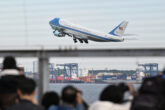June 13, 2016
The U.S.-Japan Alliance: Responding to China’s A2/AD Threat
In this paper, Japan Maritime Self-Defense Force Vice Admiral (Ret.) Yoji Koda looks into China’s regional and underlines the importance of a closely knit U.S.-Japan alliance that can both strengthen U.S. presence in the region and complement military capabilities to counter the threat from China. Koda defines the A2 and AD threat separately, with ASBMs, submarine forces, counter-domain superiority as A2 efforts targeting U.S. force flow into the region, and land attack missiles, special force sabotage, island seizure as AD efforts targeting U.S. forces already postured within the region. His prescription is to develop countermeasures such as missile defense capabilities to offset the A2/AD threat, while leveraging the alliance’s current advantages to exploit China’s vulnerability and impose cost.
The report is available online.
More from CNAS
-
Trump’s Week in Asia: Gifts, Deals, and Submarines
This article was originally published on War on the Rocks. Trump’s trip generated several positive outcomes. He showed up, which matters disproportionately in far-flung Asia. ...
By Jacob Stokes
-
Defense / Indo-Pacific Security / Technology & National Security
To Compete with China on Military AI, U.S. Should Set the StandardsThe United States has an opportunity to lead in global norms and standards for military AI at a critical moment, when the foundations laid today could shape how militaries use...
By Jacob Stokes, Paul Scharre & Josh Wallin
-
Arirang News | China to Host APEC 2026
Dr. Go Myong-hyun, CNAS adjunct senior fellow, joined Arirang News to discuss the closing of the recent APEC Economic Leaders' Meeting 2025, the upcoming summit between Chines...
By Dr. Go Myong-Hyun
-
Why Chinese Car Investments Are a National-Security Risk
If the U.S. wants to win the competition for technology and security, it must distinguish between productive investment and Trojan horses....
By David Feith




